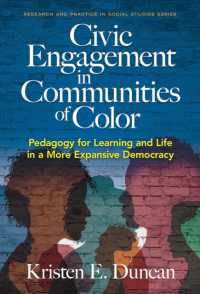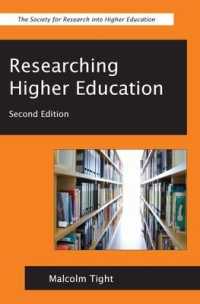Full Description
In this indispensable work, prominent authorities review the latest research on all aspects of ELL instruction (K-12) and identify what works for today's students and schools. Provided are best-practice guidelines for targeting reading, writing, oral language, vocabulary, content-domain literacies, and other core skill areas; assessing culturally and linguistically diverse students; and building strong school-home-community partnerships. Chapters include clear-cut recommendations for teaching adolescent ELLs and those with learning disabilities. The comprehensive scope, explicit linkages from research to practice, and guidance for becoming a culturally informed, reflective practitioner make the book an ideal course text.
Contents
Foreword, Lee Gunderson
Introduction, Guofang Li and Patricia A. Edwards
I. Perspectives on ELL Instruction
1. Improving Achievement for English Learners: Conclusions from Recent Reviews and Emerging Research, Claude Goldenberg
2. Language Development and the Education of Dual-Language-Learning Children in the United States, Eugene E. GarcÃa and Erminda H. GarcÃa
II. Strategies for Teaching Young ELLs
3. Principles for Teaching Young ELLs in the Mainstream Classroom: Adapting Best Practices for All Learners, Ellen McIntyre
4. Engaging Young ELLs with Reading and Writing, Diane Barone
5. Principles for Writing Practices with Young ELLs, Sarah McCarthey and Xun Zheng
III. Strategies for Teaching Adolescent ELLs
6. Teaching Academic Literacies in Secondary School, Harriett Allison and Linda Harklau
7. Constructing Access and Understanding in Inclusive Middle-Grade Content Classrooms: A Sociocognitive Apprenticeship in Literacy with Bilingual Students and Those with Language/Learning Disabilities, Troy V. Mariage and Carol Sue Englert
IV. Best Practices in ELL/Bilingual Programs and Approaches
8. From Models to Principles: Implementing Quality Schooling for ELLs, Ester J. de Jong
9. Using Workshop Approaches to Support the Literacy Development of ELLs, Kathryn H. Au and Taffy E. Raphael
10. A Bilingual Perspective on Writing Assessment: Implications for Teachers of Emerging Bilingual Writers, Lucinda Soltero-González, Kathy Escamilla, and Susan Hopewell
V. Critical Issues Concerning ELL Instruction
11. Meeting the Needs of ELLs with Disabilities: A Linguistically and Culturally Responsive Model
Alba A. Ortiz and Alfredo J. Artiles
12. Best Practices for Native American Language Learners
Mary Eunice Romero-Little
13. Supporting Literacy Learning in Families for Whom English Is an Additional Language
Jeanne R. Paratore, Barbara Krol-Sinclair, Mariela Páez, and Kristen Paratore Bock
14. “It’s Just Like Telling Them They Will Never Be Scientistsâ€: A White Teacher’s Journey Transforming Linguistic and Racial Categories, Cynthia H. Brock, Julie L. Pennington, Eleni Oikonomidoy, and Dianna R. Townsend
15. Best Practices in Professional Development for Teachers of ELLs, Guofang Li and Maria Selena Protacio







